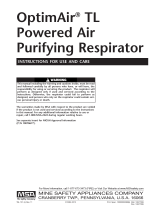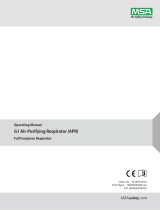
TAL 702 (L) Rev. 0 © MSA 2007 Prnt. Spec. 10000005389(A) Mat. 10083108
Doc. 10083108
The warranties made by MSA with respect to the product are voided if
the product is not installed, used and serviced in accordance with the
instructions in this manual. Please protect yourself and/or your employ-
ees by following the instructions. Please read and observe the WARN-
INGS and CAUTIONS inside. For any additional information relative to
use or repair, write or call 1-800-MSA-2222 during regular working
hours.
THIS MANUAL MUST BE CAREFULLY READ AND FOLLOWED BY ALL
PERSONS WHO HAVE, OR WILL HAVE, THE RESPONSIBILITY FOR
USING THE S-CAP FIRE ESCAPE HOOD. THESE ESCAPE HOODS WILL
PERFORM AS DESIGNED ONLY IF USED AND SERVICED ACCORDING
TO THE INSTRUCTIONS; OTHERWISE, THE ESCAPE HOOD COULD
FAIL TO PERFORM AS DESIGNED, AND PERSONS WHO RELY ON THE
ESCAPE HOODS COULD SUSTAIN SERIOUS PERSONAL INJURY OR
DEATH.
Fire Escape Hood
OPERATION AND INSTRUCTIONS
TM

INTRODUCTION
• The S-CAP Fire Escape Hood is not approved for
entry into a contaminated environment, nor for res-
piratory protection while working.
• An adequate respiratory protection program must
include knowledge of hazards, hazard assessment,
selection of proper respiratory protective equip-
ment, instruction and training in the use of equip-
ment, inspection and maintenance of equipment,
and medical surveillance.
• This respirator will perform as designed only if
used and maintained according to the manufactur-
er's instructions. The Program Administrator and
the users must read and understand these instruc-
tions before using or servicing this product.
• Do not alter, modify, or substitute any components.
• This respiratory protective device does not supply
oxygen. Use only in adequately ventilated areas
which conform to the appropriate standard.
• Use strictly according to the instructions, labels,
and limitations pertaining to this device.
• Wear impermeable protective clothing to prevent
exposure to gases and vapors which can poison by
skin absorption.
• The S-CAP Fire Escape Hood provides LIMITED
protection. It is EN403 approved for respiratory
protection during escape only for up to 15 minutes
from smoke, carbon monoxide, acrolein, hydrogen
chloride, hydrogen cyanide, and sulfur dioxide
associated with fire.
• Do not use without a complete understanding of
the instructions and limitations for this respirator
and proper training. Misuse can prevent the respi-
rator from providing the necessary protection.
• The S-CAP Fire Escape Hood must be stored in its
original, unopened bag until needed for escape. It
is recommended the respirator be kept in the origi-
nal packaging for additional protection.
• The hood is for single use ONLY and must NEVER
be reused. Dispose of hood if used, damaged, or
the expiration date is exceeded.
• Do not use a damaged S-CAP Fire Escape Hood.
• The S-CAP Fire Escape Hood is not designed to
provide respiratory protection in the presence of
CBRN agents.
• Do not remove hood in contaminated atmosphere.
• Remove all jewelry or other items that could dam-
age respirator while donning/wearing.
• Ensure zippers or other garment objects do not
interfere with donning/wearing.
• Do not don this hood in environments where the
temperature is below 10°F. Once donned, do not
wear it in temperatures below 0°F.
• Do not store the S-CAP Fire Escape Hood below
0°F or above 120°F. The temperature inside a vehi-
cle can exceed 120°F.
Failure to follow the above warnings, in addition to all
instructions, can result in serious personal injury or
death.
2
TAL 702 (L) Rev. 0 - 10083108
TABLE OF CONTENTS
Introduction .............................................................................................................................................................................2
G
eneral Description .................................................................................................................................................................3
Donning....................................................................................................................................................................................5
Removing the Respirator .........................................................................................................................................................7
Storage.....................................................................................................................................................................................7
Shelf Life and Maintenance .....................................................................................................................................................9
S
-CAP Escape Hood Assemblies..........................................................................................................................................10

DESCRIPTION
GENERAL DESCRIPTION
The S-CAP Fire Escape Hood complies with EN 403:2004
a
nd is designed to provide respiratory protection during
escape for up to 15 minutes from smoke, carbon monox-
ide, acrolein, hydrogen chloride, hydrogen cyanide, and
sulfur dioxide associated with fire. Inhaled air is drawn
through the canister, which contains absorbents and a fil-
t
er that removes or neutralizes specific contaminants.
Exhaled air leaves the facepiece through the exhalation
valve.
It is important for the user to become familiar with the
application and operation of the S-CAP Fire Escape
Hood.
TRAINING
The S-CAP Fire Escape Hood is available in one universal
size.
Before using the S-CAP Fire Escape Hood, the user must
v
iew the presentation video to obtain necessary instruc-
tions and to become familiar with the operation of the
h
ood. This is necessary since the S-CAP Fire Escape
Hood must not be deployed until an actual escape situa-
tion
Preparations for Use
•
Remove all jewelry (earrings, necklaces, rings) or other
items that could damage respirator while donning and
wearing.
• Ensure zippers or other garment objects do not inter-
fere with donning.
Sharp edges on jewelry or zippers may cause tearing
of the hood material.
3
TAL 702 (L) Rev. 0 - 10083108

NOTES
4
TAL 702 (L) Rev. 0 - 10083108

DONNING
DONNING
1. Remove the S-CAP Fire
Escape Hood from from
s
torage packaging.
2. Remove the foil bag
and remove the S-CAP
Fire Escape Hood.
3. Insert both hands
through the neckseal,
expand hands and pull
the neckseal over head.
4. Pull straps towards the
back of head with both
hands to tighten face-
piece.
5. Once the S-CAP Fire
Escape Hood is
donned, evacuate dan-
ger area.
• Be sure not to place finger nails in a position that
would tear or rip the neck seal while donning.
• If eyewear is worn, be sure to expand the neckseal
outward far enough to clear the eyewear during
donning. If the neck seal or hood material
becomes torn or damaged the result may be seri-
ous personal injury or death.
The S-CAP Fire Escape Hood neckseal may not pro-
vide satisfactory protection if hair, clothing, or other
conditions prevent direct contact with the skin. Failure
to follow this warning may result in serious personal
injury or death.
After donning the S-CAP Fire Escape Hood, breathe
calmly and immediately proceed to fresh air.
Do not break the seal between your neck and the res-
pirator during use. Failure to follow this warning can
result in serious personal injury or death.
5
TAL 702 (L) Rev. 0 - 10083108
Wall Box
Cardboard Box

NOTES
6
TAL 702 (L) Rev. 0 - 10083108

DOFFING
Do not remove respirator until respirator and protec-
t
ive clothing are decontaminated; otherwise, exposure
to contaminants may result. Follow decontamination
and disposal procedures established by appropriate
authorities. Failure to follow this warning may result in
serious personal injury or death.
REMOVING THE RESPIRATOR
• Lift the front of neckseal and move canister up and
over head.
• Disposal of the respirator is to be performed as
required by federal, state, and/or local laws.
Note: The S-CAP Fire Escape Hood is not reusable.
STORAGE
• Store the S-CAP Fire Escape Hood in dry, clean con-
ditions out of direct sunlight.
• The S-CAP Fire Escape Hood must be stored in its
o
riginal, unopened bag until needed for escape. It is
recommended the respirator be kept in the original
p
ackaging for additional protection. If used, the stor-
age case must not be sealed.
T
he S-CAP Fire Escape Hood must be stored in its
original, unopened bag until needed for escape. It is
recommended the respirator be kept in the original
packaging for additional protection.
• Follow the shelf life expiration date.
• Do not store the S-CAP Fire Escape Hood below 0°F
or above 120°F. The temperature inside a vehicle can
exceed 120°F.
Do not use an expired respirator. Failure to follow this
warning can result in serious personal injury or death.
7
TAL 702 (L) Rev. 0 - 10083108

NOTES
8
TAL 702 (L) Rev. 0 - 10083108

SHELF LIFE AND MAINTENANCE
SHELF LIFE AND MAINTENANCE
Note: The initial expiration date marked on the foil bag
l
abel is 4 years from the date of manufacture. Extended
storage life testing must be performed before this initial
expiration date.
Shelf Life and Test Frequency
T
he S-CAP Fire Escape Hood has a normal shelf life of 4
years. This period may be extended if the following crite-
ria are met. See chart.
a. If storage location is in a vehicle see table 1.
b. If storage location is in a building see table 2.
Test Criteria
The S-CAP Fire Escpe Hood is stored in a vacuum foil
bag:
1. The foil bag for the S-CAP Fire Escape Hood must be
air tight and intact.
2. The physical weight of the S-CAP Fire Escape Hood
must not increase in excess of 2 grams within the total
shelf life.
Test Procedure
1
. Visually check the foil bag. Make sure it is not dam-
aged and is still intact.
2
. Weight control: On the upper corner of the foil bag
you will find a label with the exact weight at the time
of production to the accuracy of 0.1 grams as well as
month and year of the required first test (4 years after
production). Use a calibrated balance with an accura-
c
y of 0.5 grams to weight the foil bag.
Test Results
1. Positive: If the foil bag is intact and the maximum
weight increase amounts to 2 grams the shelf life of
the S-CAP Fire Escape Hood may be extended for 2-4
additional years (see chart). Print the second test date
on the label using a felt pen.
2. Negative: If the foil bag is damaged or the weight
increase exceeds 2 grams the S-CAP Fire Escape
Hood must be discarded and replaced in order to
avoid severe safety risks of the user
9
TAL 702 (L) Rev. 0 - 10083108
Production Test 1 Test 2
1 2 3 4 5 6 7 8
Normal Shelf Life
Maximum Shelf Life
Extended
Life 1
Extended
Life 2
# of
Years
Production Test 1 Test 2
1 2 3 4 5 6 7 8 9 10
Normal Shelf Life
Maximum Shelf Life
Extended
Life 1
Extended
Life 2
# of
Years
Table 1
Table 2

S-CAP RESPIRATOR
10
TAL 702 (L) Rev. 0 - 10083108
Part Number Description
1
0064644 Universal Size S-CAP Fire Escape Hood, Cardboard Box
10064645 Universal Size S-CAP Fire Escape Hood, Wall-mount Box


/



